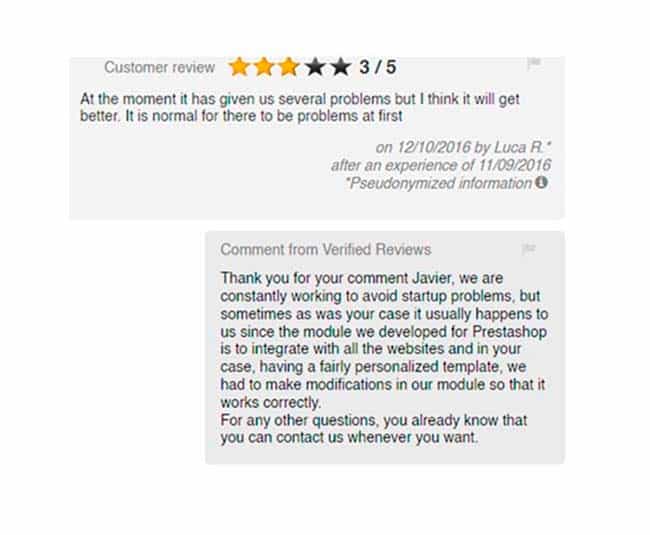Most things in life need specific ingredients to function properly. If you’ve ever forgotten to put eggs in a cake, you’ll know what I mean!
If your recipe to demonstrate the ROI of your customer experience doesn’t include the 3 types of actions (ingredients) listed below, then it simply won’t work. And with no ROI on the menu, your customer experience will inevitably be unbalanced.
The 3 necessary ingredients are:
- Micro-actions
- Macro-actions
- Cultural actions
Micro Customer Experience Actions to Obtain ROI
Responding to a customer who gives you a poor score and/or asks to be contacted is an essential type of action to improve your customer experience. Add it to your recipe.
Resolving a problem at first contact is a widespread objective in most organisations that care for their customers.
In an omnichannel context, the level of response should be the same whether the customer calls, sends an email, SMS, posts a comment or starts a chat conversation.
Dashboards displaying customer feedback in real time are also commonplace in most companies. This process provides the means to follow-up on dissatisfaction and inform each manager of any specific issues.
The development of customer interaction platforms has helped customer experience managers to understand the importance of micro-actions. They are “micro” because they deal with one customers’ issues at a time. Managing your customers’ problems on a case-by-case basis can significantly reduce the risk of them leaving you for the competition.
So, how do you measure the ROI of this type of action? Calculate the revenue generated by customers following a dissatisfaction and perform the same calculation after implementing micro-actions. You’ll soon make back the cost of dealing with a dissatisfied customer.

Macro Customer Experience Actions to Obtain ROI
Micro-actions allow you to put a plaster on a wound in an individual and personalised way. But as the old saying goes, “prevention is better than cure”.
Universal “pains” have the greatest impact on customer experience, brand perception, corrective spending and churn.
Customer Experience
First impressions are decisive. You rarely get a second chance. Getting customers to forget or forgive a faux-pass often takes time and investment.
Brand Perception
The overall feel of your experience either reinforces or undermines the brand values you wish to convey.
Corrective Spending
Corrective spending is any financial investment in something that didn’t work in the first place.
Technologies (such as Smart Surveys) help to identify the shortfalls of a product, service or distributor (partners, suppliers) in order to take the necessary corrective actions.
A company’s support team’s policies and processes can also easily be reviewed.

Customer Churn
One of the main reasons customers leave is an incompatibility with the way a company works.
Customers will forgive occasional weaknesses in your organisation. But if your overall customer experience and service does not match the user’s expectations, then the customer relationship is likely to sour, or even come to an end.
Macro customer experience actions address universal or widely shared customer “pains”. This usually requires in-depth analysis of different customer groups to get to the bottom of the problem and prevent it from reoccurring. A CRM overview will help you gain perspective on the reasons for these blockage points.
Cross-company collaborations (brainstorming, validation, resolution and creation of answers to customer problems) are tools for macro customer experience actions.
Cultural Customer Experience Actions to Obtain ROI
To be successful, you need to engage all your employees. They must be aware of the importance of customer experience and the impact of their actions and behaviour at each point of contact.
Getting employees involved in cross-functional customer experience actions is rare in companies, especially among teams that are not in direct contact with customers.
Cultural customer experience actions consist in focusing employee attention and behaviour on customer wellbeing and success.
To measure the ROI of this type of action, test your organisational policy on a pilot team and measure their incremental performance.
If you succeed, the whole company will be focused on making customers happy.
Customer experience actions can therefore be closely linked to the company’s vision, mission, values, exceeding goals, team recognition, promotion criteria, investment criteria, and so forth.
The Recipe and ROI for Success
For the best results, ensure that all the ingredients are ready before you get started.
If you’ve already begun, the good news is that, unlike when baking a cake, you can add missing ingredients to the customer experience as you go along. Better late than never!
And since you’re adding items as you go, it’s easy to check the benefits they generate by comparing before and after.
When these 3 ingredients are combined, your return on investment is significantly higher. This will help you secure your company’s position for a long time to come.
 hbspt.cta.load(20304540, ‘cb2d0916-f405-47e9-bb18-4064b993938a’, {“useNewLoader”:”true”,”region”:”na1″});
hbspt.cta.load(20304540, ‘cb2d0916-f405-47e9-bb18-4064b993938a’, {“useNewLoader”:”true”,”region”:”na1″});


















